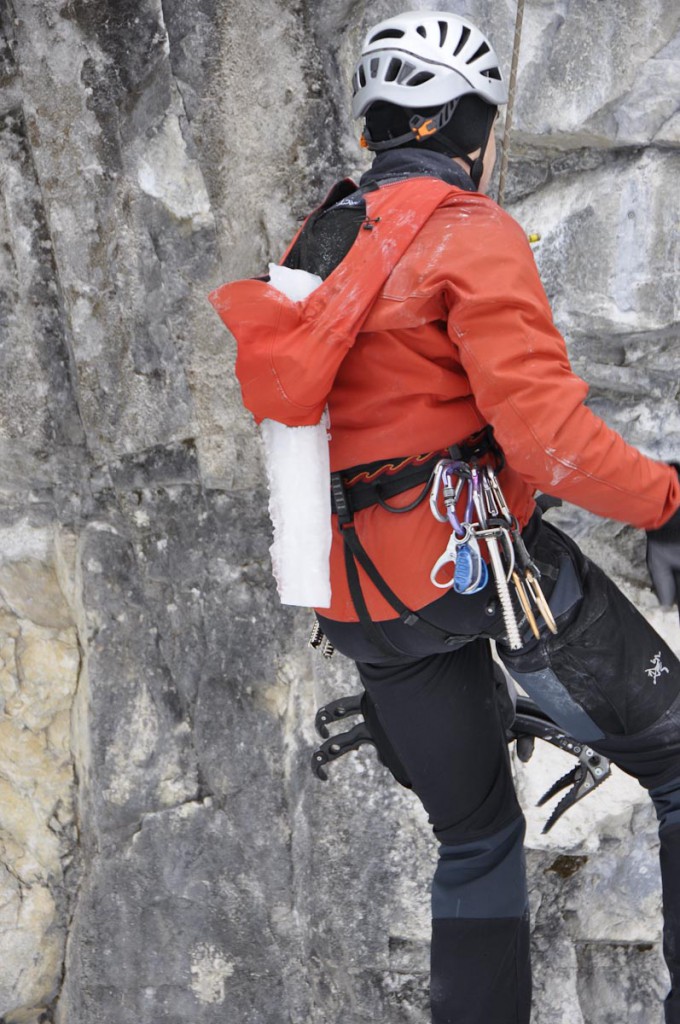Date: 4th March 2013
 I’m on a bit of a “negative” blog posting pattern lately, but I keep seeing some rather, ah, well, stupid behaviour out there that I feel the need to comment on because it’s just so totally unnecessary, and I’m running out of Steri Strips in the first aid kit.
I’m on a bit of a “negative” blog posting pattern lately, but I keep seeing some rather, ah, well, stupid behaviour out there that I feel the need to comment on because it’s just so totally unnecessary, and I’m running out of Steri Strips in the first aid kit.
One of my main rules for ice climbing is, “If you get hit with falling ice it’s your own damn fault, and you deserve it.” Ice falls; I don’t want to hear a call of “ICE!!!” unless the whole climb is falling down. Yelling “Ice” while ice climbing is like yelling “PUCK!” in a hockey game or something, it’s part of the sport. We should all be approaching ice climbs with the knowledge that falling water ice really really hurts at best; I view falling ice as extra sharp-edged rocks. Nobody would stand under someone climbing a loose choss heap and dropping rocks, but somehow on an ice climb the inexperienced often seem to think it is. Weird, I know, but I see it all the time.
Here’s the list of “don’t do this” stuff:
-Don’t climb below another party on an ice route. You will get hit with falling ice from them, as they WILL drop ice. If that ice hits you it’s your own fault (see the comments below–this is not the first broken arm/face/head I’ve heard of from climbing below another party).
-Keep everyone either well back from the climb if top-roping, or well off to the side. In every clinic I teach someone creeps in toward the climb while I’m coaching someone else, and either gets a little surprise slap from a piece of ice or (usually, my clinic participants get the “Ice falls, don’t be in the way talk first thing) someone else in my clinic gets them to move back out. Lifeguard each other to maintain proper distance from the climb. Ice will fall down, it’s totally expected, so only yell “Ice!” when you knock down a really big piece that has the potential to fly farther out than anyone expected. Continually yelling ice makes it meaningless, and again, falling ice is expected, part of the sport…
-Don’t put your belays in open places where falling ice from the leader will hit you. Remember that ice will bounce farther and farther to the sides as the leader gets higher; from 40M up ice can easily bounce 10M to either side. Ice climbing involves falling ice, and standing under it (especially if tied in place) is a recipe to get smacked. As I recently said in the comments, I can tell how experienced a party is at multi-pitch climbing by where they put their first belay. If it’s in a sheltered cave then I know they have a clue. If it’s a nice sunny alcove directly under the next pitch then I know they are from England, Australia or Colorado… “Ouch Mate, why’d you drop that on me arm!” ‘Cause it’s ice climbing silly Brit… I’m picking on the Brits here because they can take it and I love ‘em, but I see a lot of this in Rjukan, the Weeping Wall and other places that attract large quantities of relatively inexperienced climbers from relatively iceless locations.
-Don’t climb too far apart vertically when simul-seconding or climbing two parallel lines on a wide waterfall or alpine face. Put the belayers to the sides on the first pitch, they second at the same time to a protected belay in the middle of the climb. Leaders head out to the sides, belay out there or in a protected place, repeat. The result is a sort of diamond-shaped track up the route. If one climber gets very far above the other and they are at all close the ice will bounce sideways enough to cause problems…
-Don’t top-rope the first pitch on multi-pitch routes while climbers are still above. Seriously! As unbelievable as this might seem, people do it regularly, and get smoked as a result. I would have thought this would be obvious, but no, apparently not… There was a recent accident near Canmore involving this scenario.
-Don’t forget to communicate when rappelling multi-pitch routes with people coming up. Hanging out in space on the rap line while pizza-sized dinner plates go flying by just sucks. Talk with the other climbers, make it all work in a friendly way, it can be done safely but takes open coms, a willingness to work together and perhaps a little more time to do it safely.
-Don’t belay at the base of the rout and get all annoyed when the leader drops a foot-ball sized chunk on your shiny, now destroyed helmet… Ice falls, stand out of the way. Anchor yourself way off to the side if the leader is climbing free-hanging pieces of ice. I’m totally amazed no one has been killed in Haffner (there have been some bad accidents there).
-Don’t let a bad situation develop. Often people get so worked up about going climbing that they forget their common sense. You can’t be shy about saying, “Hey, if you start climbing across above me me right now as I belay my leader you’re going to drop ice on me, please don’t do that!” If they keep going then you need to be direct, forceful and clear, they are endangering your safety, and probably just do not understand the danger they are putting you into. Hoping for a good outcome is not enough. A lot of novice ice climbers are simply clueless about the damage ice can do. Also be careful as new climbers enter an area you’re climbing in; assume they are clueless, and often people walking around won’t have their helmets on. They need some minding, a quick, “Hey, she’s knocking a lot of ice off, you might want to wait a minute until she’s done or walk wide around the base ” is a good thing to say.
-Don’t let accidents happen: If someone starts leading up below you then yell down, “Hey, I’m going to be dropping lots of ice, and if it hits you on lead it could break your arm or head, and definitely knock you off. I’d feel bad about that and have to help clean up the mess, you’ll want to wait!” If they keep leading below you then they have been warned, but you’ve got to give solid warning and allow them time to retreat. It’s like pistol duels back in the day, play fair and then let evolution do it’s thing… Hopefully not, but I see too much of this sort of thing to believe climbers will naturally figure it out.
So, in the picture below there are two parties climbing. The top leader has put his belayer exactly in the line of fire. Another party has started up below the top leader’s belayer, and was climbing while the top leader was leading. The really amazing thing is that the top leader has put his belay exactly in the line of fire, AGAIN, and again pummelled his belayer as he led up the last pitch. Plus it was extremely dangerous for the lower climbers, who were still climbing… This route is climbed and guided regularly with reasonable safety; put the belayers in the obvious caves and the safety margin would have been vastly higher. And this photo is from Hydrophobia, a grade 5, where one might expect that the climbers would know a little about multi-pitch ice climbing. Some of them are friends of mine and nobody got too beat up, but they are primarily rock or alpine climbers, and made a few classic mistakes while I had a camera handy, doh! I did see one of them a few days later sporting a nice big facial bruise… I’d say that was lucky. Ice climbing is dangerous enough when you do everything right.
Rant off, ice climbing is a beautiful sport I love, and it seems to be growing in popularity. This is great, but the knowledge transfer isn’t growing at the same rate. Safe climbs!
Posted in: Blog
Tags: Ice Climbing, Rant, Safety
LOL. I love it when you rant, Coach.
Legit post Will. I climbed weeping pillar last year and was shocked when I heard a party coming up direclty below my partner and me. They even used the same belay spot we had just occupied. We were totally safe in our belay locations, but the party below us was getting hit and ended up breaking an arm! He was yelling and screaming at us, but I just couldn’t believe he didn’t expect to get hit. Turns out it was in fact a Black Diamond athelete. I was even more shocked to hear that. Just because you can climb steep ice doesn’t mean you should stop using your head.
natural selection
wondering who is using ozman? Not that I own it, but I have been using ozman05 for several years.
Yea, although I am a weekend warrior as far as climbing is concerned, everything in Will’s rant is commonsense but so many climbers have no clue in this regard. Had a party climb up behind me & put in a belay alongside me, right below the obvious line above. The guy seemed to be oblivious to the danger he put his party in.
Brit bashing…..ouch……..but justified. I was in Scotland last week and the amount of poor belays (both position and build) we’re abundant. Changeovers were also very slow but the most common occurrence was blown points due to heels lifting when reaching.
There were indeed lots of us in Setesdal this year, great conditions and good to be away from the rime, but still a lot of poor form displayed, this explanative example.
We met a group who said they choose to come to Norway each year as its cheaper than traveling to Scotland ( they are in London) and the conditions are more guaranteed. All the kit, stoked, but when questioned In total they climb 5 days of ice a year; and it showed. This is a common theme.
Building an intelligent belay for the medium and technique employed should be a base skill for any climber, ice isnt trad, if its new to you then get trained and mentored.
You guys are lucky, we don’t have a piece of ass to give us a surprise slap………….(ref: paragraph 4)
Happy birthday for Friday….
Another solution is to move to Norway (from the UK!) and climb all winter without seeing one other climbing party.
I really appreciate this break down of the do’s and don’ts – as a newbie who’s been out with more experienced people (side eye to Raf), I’ve been hit once with ice and it sure did hurt! Admittedly, I was standing in the wrong place but I really had no idea – and there were four experienced climbers standing by who set me up as a belayer ….
just chatting with Raf now, I think it can be a taken for granted that everyone knows this stuff – especially if you’re climbing with someone new. it’s so obvious to the more experienced that they probably don’t even think to raise it. And the newbie is just almost stunned by a mix of anticipation, excitement, sprinkled with some fear (and in my case a horrible understanding of physics!), that I didn’t even know what questions to even ask!
I understand I have to take personal responsibility but the big lesson I take from this is to ensure I’m communicating and not being afraid to ask questions (even if it’s broad like “is there anything I’m supposed to know that you think I know but I likely don’t? haha), and to just ensure that any assumptions about each other’s skills/knowledge are checked before climbing…Thanks Will!
I think the point regarding a top-rope environment can’t be understated, and I think that the really insidious thing is the way a crowded crag invariably brings complacency into the situation once a group is parked somewhere for hours. Just being in such an environment seems just as hazardous as being the belayer – perhaps even more, as you’re not watching the situation quite as intently. Fairly basic and self-evident, but I have to keep reminding myself of this throughout an eight-hour day at the crag.
The other sketchy thing I’ve seen here is for the ropes to get WAY too close on crowded days in a cragging environment- schoolroom or south park in Ouray being prime examples. Quite easy for ice to bounce from route to route, and it always seems that the steady state separation between routes that a crowd selects on a crowded day is always too close – despite the fact that some of the parties involved often have a high amount of experience. Probably another manifestation of the “risky shift” heuristic trap…
Wg, I am getting the drift that many climbers do not realize that gravity is all around them, and it can actually hurt you outside. Those who venture outside from the gyms may not fully realize that jumping off the boulder into 2ft thick or more, that gym mats are not outside. I would say the same thing goes for ice climbing, where many think that falling is ok, that ice screws are like natural gear or bolts. Other than the obvious about falling on ice, the gear is simply poor, no matter how well the screw is placed, it’s into ice. The fact that you can catch your crampons on the way down can rip your ankle apart or other.
It is a bit sad that the historical perspective on climbing is fading into the rad X-games style of media hype about the present and future. The media shows snippets of the elite who are shredding, maybe solo, maybe on minimal gear, or just at the extreme limits of ability. What they don’t show is the effort that went into the “hype”, the training, and the ‘gazillion routes, training hours that went into the maybe 60 second snippets.
Take M Bendler and his training regime – it’s not a wonder that he is strong and can shred. Most of the recreators want the quick fix, simple, the effort that someone like Bendler puts in, is it really worth it? So as a pretend newbie; maybe I could just “giver” and if I fail, I’ll be ok, cause I fall in the gyms and I don’t get hurt, so the same should go for the outside, as it’s all new to me, so what harm could come?
Well, having been a climber since the mid-80’s, I can tell you that gravity can get you in many ways and when it does it either really hurts, or ends your life! I have done some ice climbing, broken a helmet with an ice hit, may sound silly, but when pulling the rope after rapping to the deck, being about 5 metres away from the strike zone, something well away knocked a baseball sized ice chunk, and then concentrating on the rope pull, my partner yelled, rather than looking up to get it in my face, I braced and it nailed my helmet, knocked me dizzy, and the helmet was broken. So gravity can get you in many ways, no need to bring it on in the winter environment, when so much is out of our control.
However, falling can happen, ice can break, rock can too. Then you will rely on those ice screws and hope that the ice is strong enough to hold the fall, but expect to leave with bruises, gashes, or via helicopter.
So back to the historical perspective – we as a community have lost it for the most part. The largest part of the new climbers are gym based and they have not been immersed in the history of climbing. Having just a basic grasp of the history, one will be able to realize that winter climbing is not like summer cragging or gym climbing. That falling and general winter climbing awareness is just as important as the climbing aspect. Falling is always a chance, the more you do it, and the higher the odds are that something will happen. Some of us are lucky that when the something(s) happen, we are still here to make comments like this. I have lost many friends to these chances, it has not stopped me from climbing, but it certainly makes me analyze my climbing choices very hard.
Cheers, jd
Ice chuck. Fall. One heck of a ride!
http://www.youtube.com/watch?feature=player_embedded&v=RH3XDM1IIkM
I'm more than happy to hear your thoughts on what I've written. Please note that all comments will be moderated before publishing. Thank you for joining the conversation.



